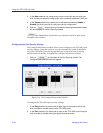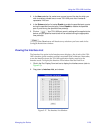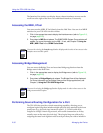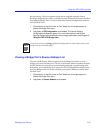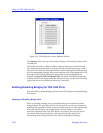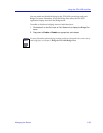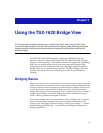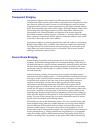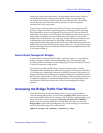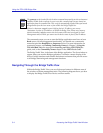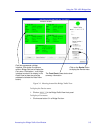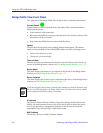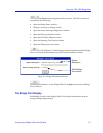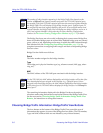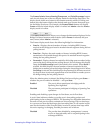
Using the TSX-1620 Bridge View
3-2 Bridging Basics
Transparent Bridging
Transparent bridges are most common in Ethernet networks. Individual
Transparent bridges monitor packet traffic on attached network segments to learn
their network segment location in terms of which bridge port receives packets
originated from a particular station (determined via the packet’s Source Address
field). This information gets stored in the bridge’s Filtering Database. When in the
Forwarding state, the bridge compares a packet’s destination address to the
information in the Filtering Database to determine if the packet should be
forwarded to another network segment or filtered (i.e., not forwarded). A bridge
filters a packet if it determines that the packet’s destination address exists on the
same side of the bridge as the source address.
Transparent bridges in a network communicate with one another by exchanging
Bridge Protocol Data Units, or BPDUs, and collectively implement a Spanning
Tree Algorithm (STA) to determine the network topology, to ensure that only a
single data route exists between any two end stations, and to ensure that the
topology information remains current.
Source Route Bridging
Source Routing is typically used to connect two or more Token Ring network
segments. Source Route bridges differ from Transparent bridges in that they do
not build and then use a physical address database to make forwarding decisions.
Instead, Source Route bridges read routing information included by the source
station and added by other bridges in a packet’s header to determine where to
forward the packet.
In Source Routing, sending and receiving devices employ broadcast packets —
otherwise known as explorer packets — to determine the most efficient route for a
message to travel. Generally, before a station sends a message, it will first send a
test packet to all stations on the same ring; if the sending station receives a
response to this packet, it knows that it does not need to include routing
information in the Routing Information Field (RIF) of this packet and all
subsequent packets it sends to the same station (i.e., the packets are not source
routed and will appear as transparent-style packets). If the sending station does
not receive a response to the test packet, it will send an explorer packet to the
destination; the explorer packet will be propagated by the network’s bridges as
either All Paths Explorer (APE) packets or as one Spanning Tree Explorer (STE)
packet. The task of both packet types is to get the destination station to return
specific route information to the sending station.
APE packets are sent to the destination station over every possible bridge path
when multiple bridge paths are available between any two local area network
stations. (Because of the method used by bridges to forward SR packets, the
presence of data loops in a network is not an issue for SR packets as it is for
packets that must be Transparently bridged.) The original APE frame contains no
routing information (e.g., bridge numbers and ring numbers); it is propagated
along all available paths to the destination station. Each bridge along the way
adds its own bridge and ring numbers to the packet’s RIF before forwarding it,



